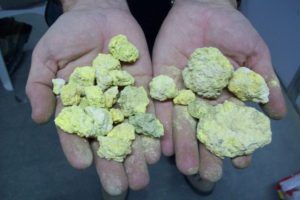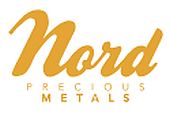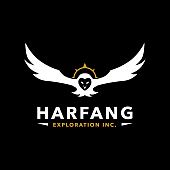 The Northern Miner/Blue Sky Uranium Proposes Low-Cost Operation
The Northern Miner/Blue Sky Uranium Proposes Low-Cost Operation
Blue Sky Uranium proposes low-cost operation at Ivana
ARGENTINA | Shallow open-pit project features anticipated US$18 per lb. uranium costs

Blue Sky Uranium (TSXV: BSK; US-OTC: BKUCF) has unveiled a preliminary economic assessment (PEA) for its Ivana uranium-vanadium deposit at its wholly owned Amarillo Grande project in Rio Negro, Argentina, highlighted by low operating costs.
“For the last three months, we’ve been busy finalizing our PEA,” Blue Sky president and CEO Niko Cacos says in an interview with The Northern Miner. “It’s a very positive PEA. It shows that the Ivana deposit is economic in today’s environment.”
According to the study, the project would produce 1.35 million lb. uranium oxide per year over a 13-year mine life at US$18.27 per lb. uranium oxide all-in sustaining costs (AISCs). The project would require US$128.05 million in pre-production capital and US$35.46 million in life-of-mine sustaining capital. It has a US$135.2-million, after-tax net present value (NPV) at an 8% discount rate, and a 29.3% after-tax internal rate of return (IRR) at US$50 per lb. uranium oxide and US$15 per lb. vanadium oxide. The project would achieve after-tax payback in 2.4 years.
“At US$18 AISCs, even if we sold it at spot, we’d be making money,” Cacos says. “So if the uranium price starts to move up, this is going to be very profitable.”
At US$60 per lb. uranium oxide, the proj-ect’s after-tax NPV improves to US$202.3 million at an 8% discount rate. The after-tax IRR jumps to 37.3%.
“The goal was, since the beginning, trying to be in the lower quartile of operating costs, and we achieve it very well,” Blue Sky vice-president of exploration and development Guillermo Pensado says. “The metallurgical process looks very simple and common, as well.”
The PEA proposes an open pit that would extend to 30 metres depth. It would be 3 km long, with widths ranging from 400 metres to 1 km. The company would mine 13,000 tonnes per day with two excavators, a front-end loader and six 31-tonne articulated trucks.
The materials are contained in unconsolidated gravels and sand, so the company would not need drill or blast operations. Recovery rates stand at 84.6% for uranium and 52.5% for vanadium.
“You just use an excavator, and then you do a scrubbing of the pebbles to remove the large, un-mineralized ones,” Cacos says. “And then you put it on the leach pad. You don’t get a simpler process than that.”
Mineralization occurs at Ivana within 25 metres of surface in two stacked zones. It is the southernmost of three target areas at Amarillo Grande.
“What’s exciting now is the upside,” Cacos says. “The potential expansion from there is this 145 km strike length zone, which we know is mineralized. It’s got potential to be 100 million lb. plus.”
Pensado adds that “our goal was: let’s try and show in this sector that we have something that could be economic. Now that we understand the geological model, we understand how to explore the other sectors.”
He goes on to say that with Blue Sky’s greater understanding of the area’s geology, it needs to retrace its steps and re-examine previously overlooked areas of the property.
The study uses an updated resource estimate for the project that Blue Sky tabled in late 2018. It includes 61 reverse-circulation holes totalling 1,043 metres the company drilled in September 2018. In total, the company has drilled 7,600 metres at Ivana to an average 15 metres below surface.
“You say, well, 7,600 metres — that doesn’t look like much drilling,” Pensado says, “but, in fact, it’s 488 holes, because they are very shallow. And due to the spacing that we have, most of them could be converted into the indicated category.”
The updated resource outlined a 17% increase in total tonnes, as well as a 19% increase in contained uranium oxide and a 13% increase in contained vanadium oxide. The updated resource totals 28 million inferred tonnes grading 0.037% uranium oxide and 0.019% vanadium oxide for 22.7 million lb. uranium oxide and 11.5 million lb. vanadium oxide.
The company will spend the next six months drilling and expanding its resource area. It aims to spend between $2 million and $3 million, drilling 8,000 metres. Towards year-end, it will begin work on a prefeasibility study for the project.
“To drill there is very low cost,” Pensado says. “It’s a flat area. We don’t need to build roads or anything. We are in the bottom of the basin, with no connection to other basins.”
“This area is less densely populated than Siberia,” Cacos adds.
Even so, the company has a paved road going all the way to its project, a railway 30 km away, a deepwater port within 100 km, and gas and electricity at site. Cacos says the Argentine government supports uranium mining, and makes and exports small, portable nuclear reactors.
Shares of Blue Sky Uranium are trading at 18’1 in a 52-week range of 12’1 to 23’1. The company has a $20-million market capitalization.
“We’ve been fortunate that we’ve been able to bring the project to this point where it is right now,” Cacos says. “We’ve seen an almost 50% rise in the price of spot uranium over the past year, and there is a sustained rise, I believe, in the price of vanadium. If these trends continue, I think timing will be perfect.
“We’ve got real value here.” TNM






















